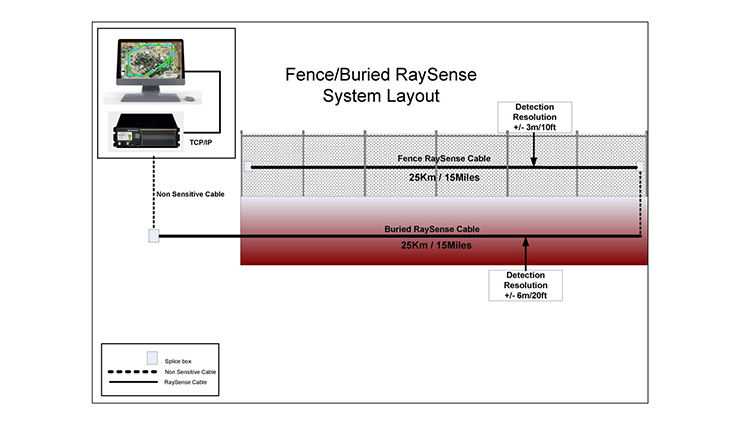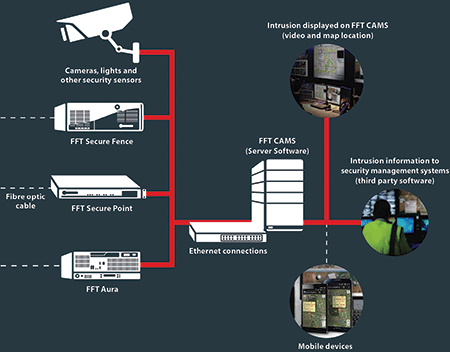Why Fiber Optic Security Systems Are the Future of Defense
The shift to fiber optic security systems notes a substantial innovation in the realm of protection, driven by their exceptional data transmission capabilities and resilience to outside disturbances. As the landscape of safety advances along with arising modern technologies such as AI and IoT, the possibility for fiber optics to boost and redefine safety and security frameworks becomes significantly obvious.
Benefits of Fiber Optic Solutions
One of the primary benefits of fiber optic systems is their superior data transfer capability, which promotes the transmission of huge quantities of data over lengthy ranges without considerable loss. This particular is particularly useful for safety and security applications that require the continual monitoring and transfer of high-def video feeds, sensing unit data, and various other critical info. Fiber optics can suit the growing demands of modern-day security systems, making certain that data stays undamaged and dependable.
Furthermore, fiber optic cords are less at risk to electromagnetic interference, which can be a substantial problem in settings with different electronic gadgets. This resistance enhances the honesty of the information being transferred, thereby decreasing the danger of information breaches or system failings. Fiber optic systems are naturally more safe than traditional copper cords, as tapping into a fiber optic line without discovery is exceedingly challenging.
The durability of fiber optic cable televisions additionally adds to their charm. They are immune to environmental elements such as dampness and temperature fluctuations, minimizing upkeep costs and enhancing system long life. Overall, these benefits position fiber optic systems as a durable and reliable choice for modern safety frameworks, ensuring reputable and safe information transmission.
Enhanced Data Transmission Speed

The capability to send substantial amounts of data rapidly assists in the smooth assimilation of high-def video clip feeds and progressed analytics. Protection systems can now process and analyze information in real-time, improving reaction times and situational understanding. Furthermore, fiber optic connections support longer transmission distances without deterioration of signal high quality, making them optimal for extensive safety networks.
The boosted rate of fiber optic systems not only improves the efficiency of safety and security operations but also reduces latency. This is specifically vital in critical scenarios where prompt decision-making can protect against safety breaches or reduce potential threats. As organizations proceed to focus on security and efficiency, the demand for rapid and trusted information transmission will definitely solidify fiber optic systems as a cornerstone of modern-day protection facilities.
Resistance to Interference
Fiber optic security systems regularly demonstrate phenomenal resistance to electro-magnetic interference, a crucial benefit in atmospheres prone to digital noise. Unlike traditional copper cables, which can be negatively influenced by electromagnetic areas, radio regularity helpful hints interference, and various other forms of electric disturbance, fiber optic cords utilize light to send data. This integral building makes sure that the signals remain clear and unchanged, no matter of surrounding digital activity.
The use of glass or plastic fibers in fiber optic technology develops a barrier versus interference, permitting dependable information transmission even in difficult scenarios such as industrial centers, urban areas with high digital traffic, or places near radio towers. This particular considerably minimizes the likelihood of signal deterioration or loss, making fiber optic systems specifically suitable for safety applications where honesty and accuracy of data are vital.
Moreover, this resistance to interference improves the general efficiency and integrity of safety and security systems, making sure that surveillance and sharp systems function perfectly. In a world where security is progressively endangered by innovative technologies, the resilience of fiber original site optic systems stands apart as an essential attribute, enhancing their standing as an important element of modern-day protection framework.
Cost-Effectiveness Over Time
Significant cost savings can be achieved in time with the application of fiber optic safety systems. While the preliminary financial investment might appear higher compared to conventional copper-based systems, the long-lasting monetary benefits become apparent via lowered functional and upkeep expenses (fiber security). Fiber optic cords are inherently much more durable and much less at risk to ecological elements, which translates to lower substitute and fixing costs over their life expectancy
Additionally, fiber optic systems require much less power to run, which even more lowers energy expenses. Enhanced data transmission capacities allow for less repeaters and amplifiers, minimizing devices investment and enhancing installment processes. The scalability of these systems likewise adds to cost-effectiveness, as organizations can broaden their security facilities without sustaining significant added expenses.
An additional element to think about is the enhanced performance in monitoring and reaction capacities that read here optical fiber offer. Improved real-time information transmission can lead to quicker event action times, possibly mitigating losses and liabilities related to safety violations. In amount, the long-term advantages of fiber optic safety and security systems not just warrant the first expense but also position them as an economically sensible option for companies looking for durable defense remedies.

Future Technologies in Security
Advancing modern technologies are readied to transform safety systems, incorporating expert system (AI) and artificial intelligence to enhance risk detection and action capacities. These innovations will enable safety systems to examine substantial quantities of information in real-time, identifying patterns and anomalies that indicate potential risks. This aggressive approach will enable faster decision-making and much more efficient event actions.
Furthermore, the consolidation of the Web of Things (IoT) is leading the way for interconnected safety and security gadgets, providing extensive monitoring and monitoring. Smart sensors can relay details concerning environmental modifications, while automated notifies can notify security employees immediately of dubious tasks.
Additionally, the development of biometric innovations will better strengthen safety systems. Facial acknowledgment, finger print scanning, and retina identification are becoming extra advanced, supplying layers of authentication that are challenging to bypass.
Conclusion
In verdict, fiber optic safety systems stand for a substantial innovation in defense innovation, providing exceptional data transmission rate, resistance to electromagnetic disturbance, and long-lasting cost-effectiveness. As the need for advanced security remedies continues to expand, the combination of optical fiber with emerging modern technologies such as AI, IoT, and biometrics will further improve security facilities (fiber security). The combination of these advancements will make sure a much more secure and responsive setting, solidifying optical fiber as a cornerstone of future safety systems
 Edward Furlong Then & Now!
Edward Furlong Then & Now! Haley Joel Osment Then & Now!
Haley Joel Osment Then & Now! Patrick Renna Then & Now!
Patrick Renna Then & Now! Susan Dey Then & Now!
Susan Dey Then & Now! Nicholle Tom Then & Now!
Nicholle Tom Then & Now!